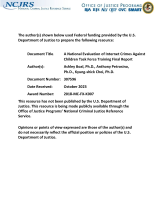Task forces
Examining the Effect of Warrior and Guardian Mindsets on Attitudes Toward Use of Force: An Analysis of US Police Recruits
Responding to Violence in Cornet City: The Problem- Solving Enterprise
Community Responses to Drug Abuse: A Program Evaluation
Drug Control Task Forces: Creating and Implementing a Multijurisdictional Unit
Draft: Assessment of Multiple Indicators of Drug Abuse for Planning and Policymaking
Multi-Agency Investigative Team Manual
Heroin Crackdowns in Two Massachusetts Cities
Case Study - New Jersey Department of Law and Public Safety Division of Criminal Justice
Case Studies - Three Organized Crime Enforcement Efforts
National Institute Host Program, Phase 4 - Final Report
Dissemination of Findings of Reduction of Fear of Crime Project - Final Report
On the Front Lines: Case Studies of Policing in America's Cities
Law Enforcement Agency Practices and Policies for the Investigation of Child Sex Trafficking: Are Agencies Using Victim-Centered Approaches?
Exposure to Child Sexual Abuse Material among Law Enforcement Investigators: Exploring Trauma and Resilience Profiles
Exploring the Intersection of Human Trafficking, Drug Trafficking, and Other Criminal Activity in the United States
Understanding the Impact of COVID-19 on Victim Services
Understanding the Impact of COVID-19 on Victim Services
The COVID-19 pandemic had a detrimental impact on communities across the nation and significantly affected various aspects of individuals’ lives. One of the negative impacts was an increase in gender-based violence accompanied by shifting barriers to accessing services and support. Victims and victim service providers faced various challenges dealing with the increase in need for services, navigating barriers to help-seeking, and addressing logistical issues.
See the YouTube Terms of Service and Google Privacy Policy




